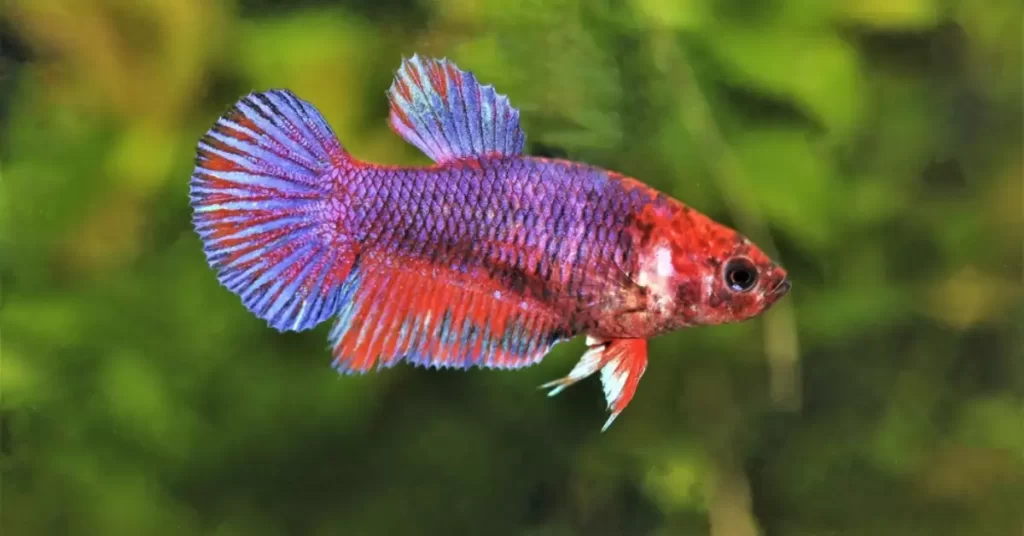Betta fish, also known as Siamese fighting fish, are a popular choice for aquarium enthusiasts due to their vibrant colors and unique personalities.
A common question that arises for betta fish owners, especially those new to the hobby, is whether female betta fish can lay eggs without a male present.
In this article, we will explore this question in depth, discussing the reproductive process of betta fish, the possibility of egg-laying without fertilization, and how to care for betta fish eggs. So let’s dive right in!
The Reproductive Process of Betta Fish
The Mating Ritual
Betta fish have a fascinating and unique mating process. The male betta fish build bubble nests at the water’s surface, which serve as a safe haven for their eggs.
When a female is ready to breed, she will approach the male and display her interest.
The male will then wrap himself around the female, and as she releases her eggs, he will fertilize them externally.
The male will then carefully collect the eggs and place them in his bubble nest.
Fertilization
In the case of betta fish, fertilization occurs externally, meaning that the male and female must be present for the eggs to be fertilized.
Once the eggs are released and fertilized, the male takes on the responsibility of caring for them, ensuring that they are safe and protected in his bubble nest.
Can Female Betta Fish Lay Eggs Without A Male?
Egg Development
Female betta fish are capable of developing eggs even without a male present.
This process is called ovulation, and it occurs as a natural part of the female betta’s reproductive cycle.
The eggs will mature inside her body, and when they are fully developed, she will release them.
Unfertilized Eggs
However, if a male betta fish is not present during the release of the eggs, the eggs will not be fertilized. Unfertilized eggs cannot develop into baby betta fish.
In some cases, the female may still lay the eggs, but without fertilization, they will not hatch.
Egg Disposal
In the absence of a male betta, the female will either reabsorb the eggs or release them into the water.
If she releases the eggs, they will often be consumed by other fish or organisms in the tank, or they may simply decompose.

Caring for Betta Fish Eggs
Breeding Tank Setup
If you are interested in breeding betta fish, it is crucial to set up a proper breeding tank.
This includes maintaining a stable water temperature, providing ample hiding spots for the female, and ensuring that the male has the space and resources to build a bubble nest.
Post-Spawn Care
Once the eggs have been laid and fertilized, it is essential to monitor the tank closely.
The male betta fish will aggressively protect the eggs, so it is often necessary to remove the female from the tank to ensure her safety.
Additionally, keep an eye on the water quality, as any significant changes could harm the developing eggs.
Hatching and Raising Fry
Betta fish eggs typically hatch within 48 hours of being laid. Once the fry emerges, they will require specialized care, including frequent feedings with high-quality food and meticulous water quality management.
Signs of Egg-Bearing Female Betta Fish
Physical Changes
When a female betta fish is carrying eggs, she may exhibit physical changes such as a rounded, swollen abdomen. This swelling can be a clear indication that the female is gravid, or carrying eggs.
Behavioral Changes
A gravid female betta fish may also display behavioral changes, such as increased activity or heightened interest in the male betta’s bubble nest.
She may also be more aggressive or defensive in her actions, as she prepares for the spawning process.
How to Encourage Betta Fish Breeding
Water Conditions
Maintaining optimal water conditions is crucial for encouraging betta fish breeding.
The water temperature should be between 78°F to 82°F (25.5°C to 27.7°C), with a pH level of around 7.0.
Regular water changes and the use of a high-quality water conditioner can help maintain a stable environment.
Diet
Providing a nutritious, varied diet for your betta fish is essential to encourage breeding.
Feed high-quality pellets or flakes, as well as live or frozen foods like brine shrimp and bloodworms. A well-fed, healthy betta fish is more likely to engage in breeding behaviors.
Tank Setup
An appropriate tank setup is crucial for betta fish breeding.
The tank should have a minimum size of 10 gallons and include plenty of hiding spots for the female, such as plants or caves.
A sponge filter is recommended, as it provides gentle water flow that won’t disturb the bubble nest.
Frequently Asked Questions
How often do female betta fish lay eggs?
Female betta fish can lay eggs as frequently as every two weeks. However, it is important not to overbreed your bettas, as this can be harmful to their health.
How many eggs do female betta fish lay at once?
A female betta fish can lay anywhere from 20 to 500 eggs in a single spawning.
The number of eggs produced depends on various factors, such as the age, size, and overall health of the female.
Can betta fish eggs be artificially fertilized?
Artificial fertilization of betta fish eggs is not commonly practiced due to the difficulty in collecting and handling delicate eggs.
Furthermore, the male betta plays a critical role in caring for the eggs in his bubble nest, making natural fertilization and care the preferred method.
Conclusion
In summary, female betta fish can indeed lay eggs without a male present, but these eggs will not be fertilized and cannot develop into baby betta fish.
If you are interested in breeding betta fish, it is essential to provide optimal conditions for both the male and female bettas, ensuring that they are healthy and well-cared for throughout the breeding process.
With proper care, you can successfully breed betta fish and enjoy the fascinating process of watching them grow and develop.